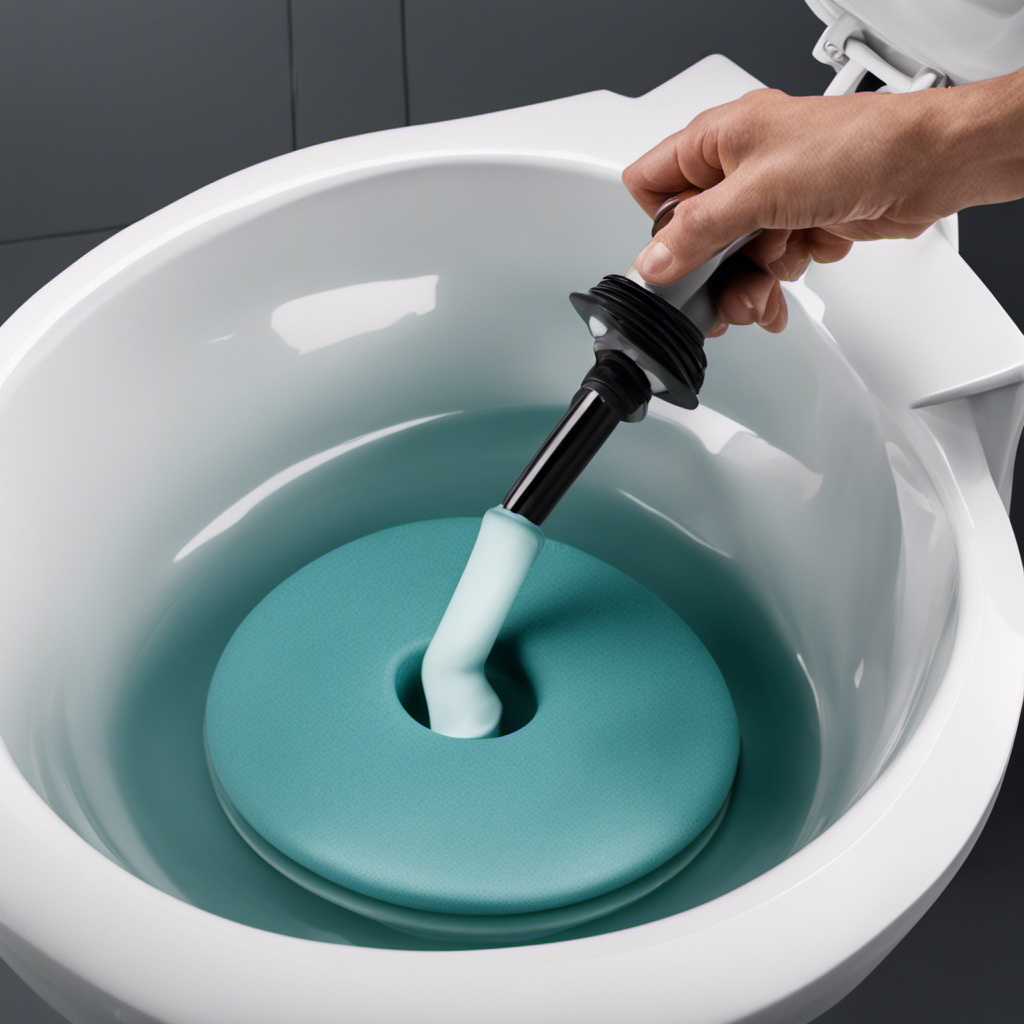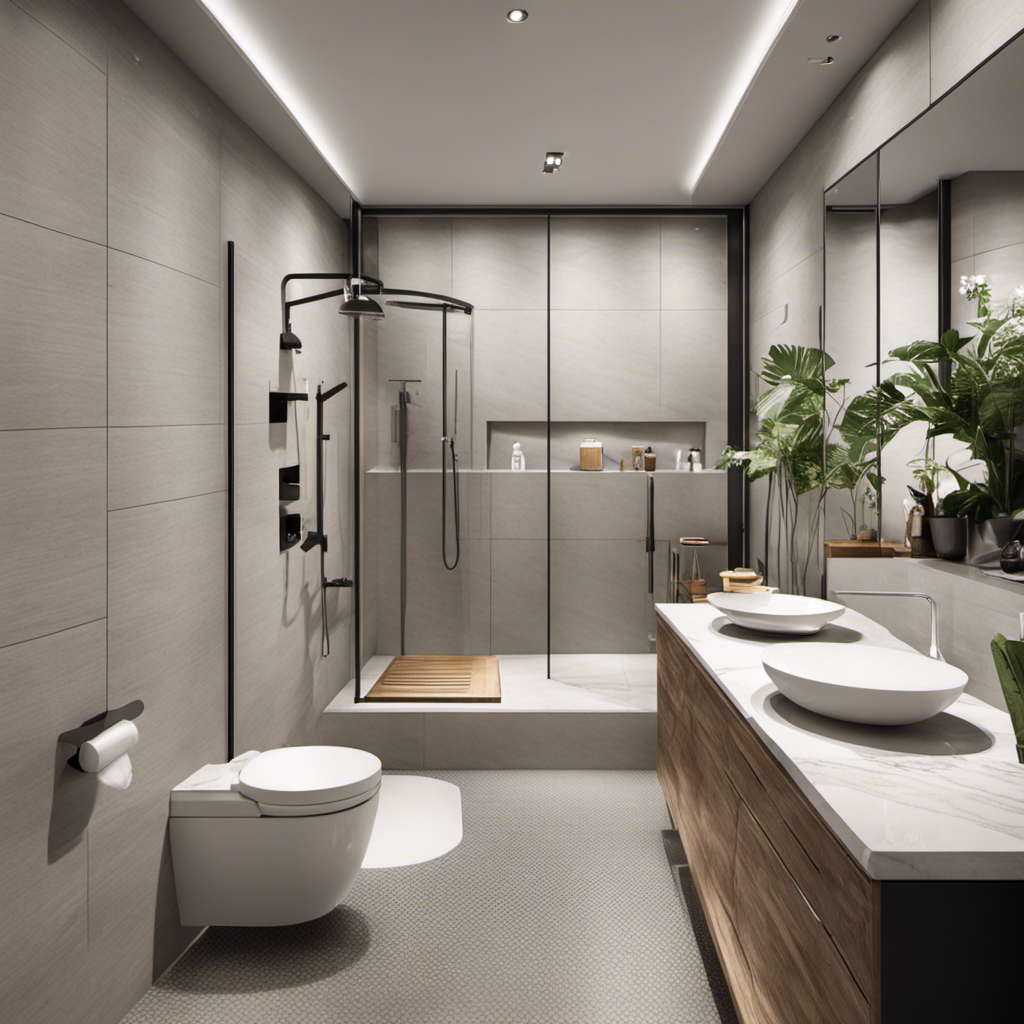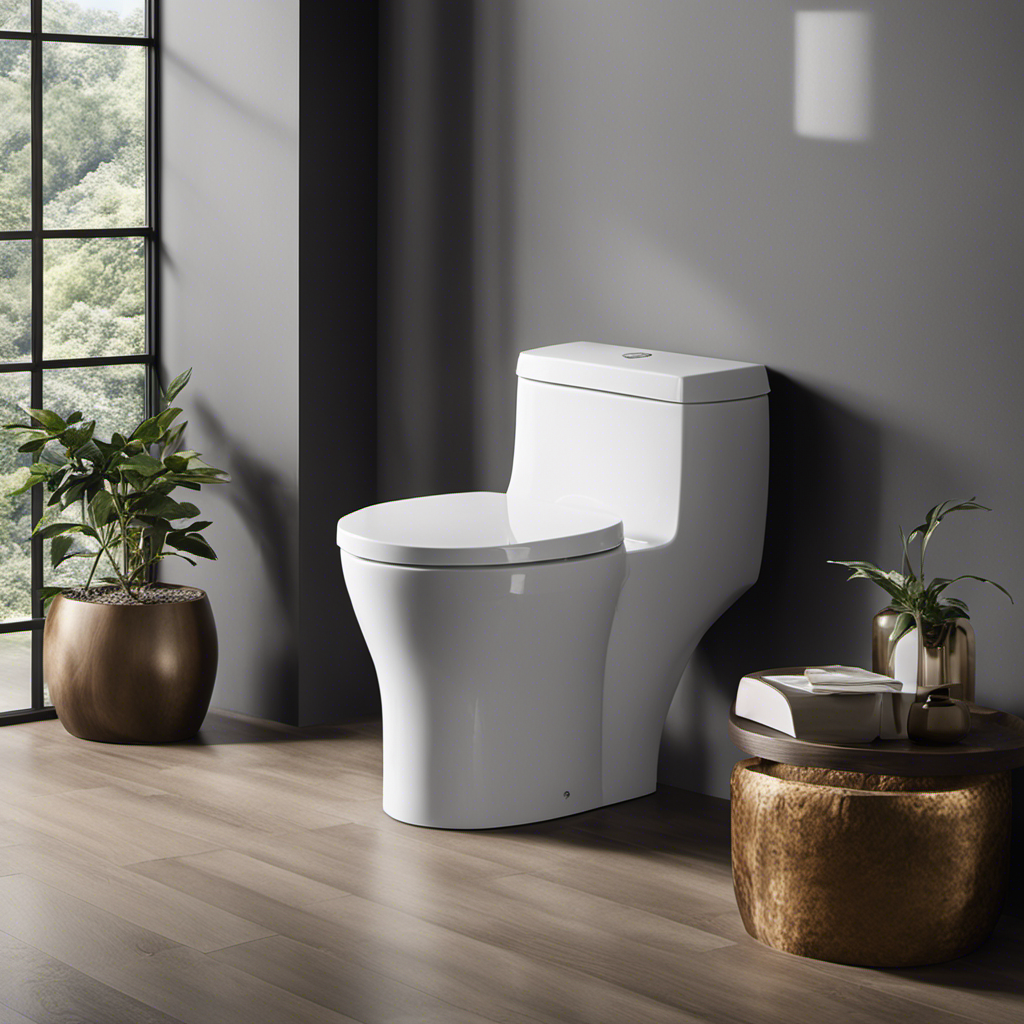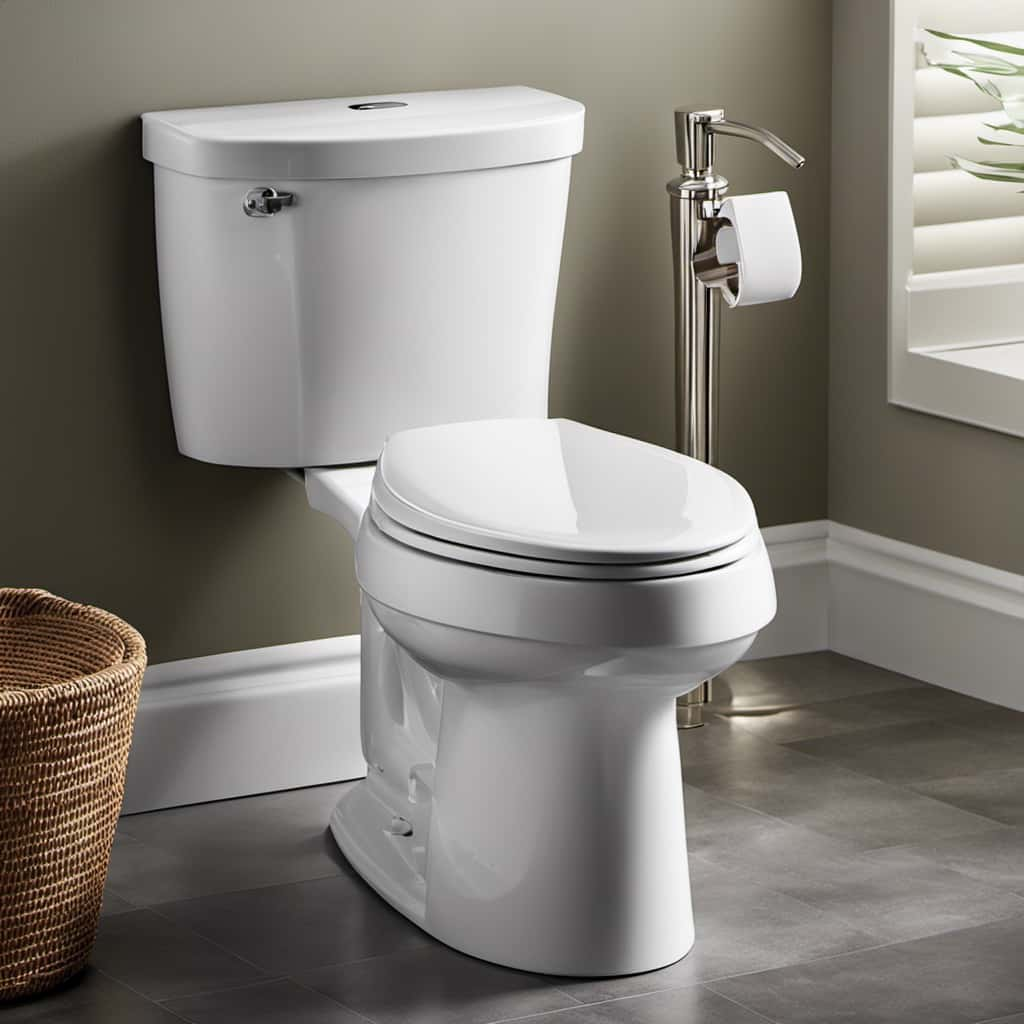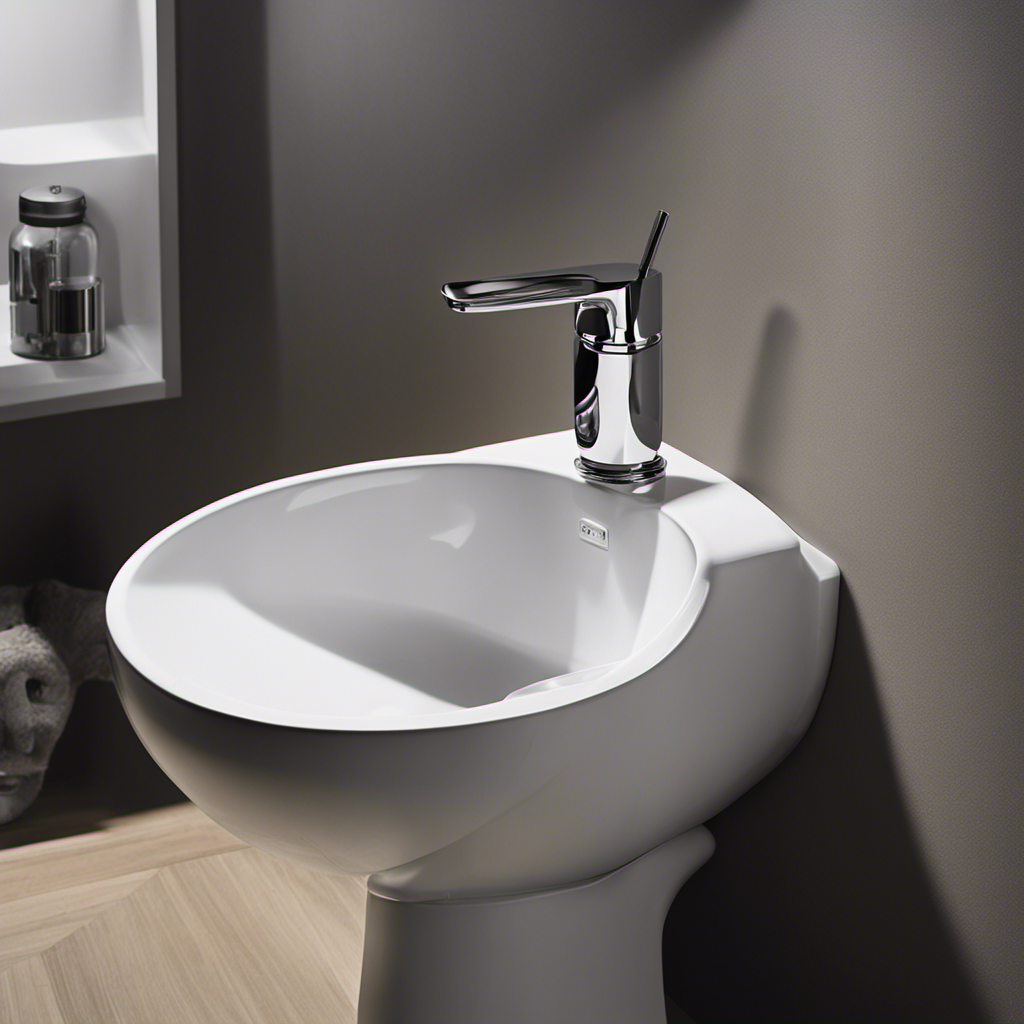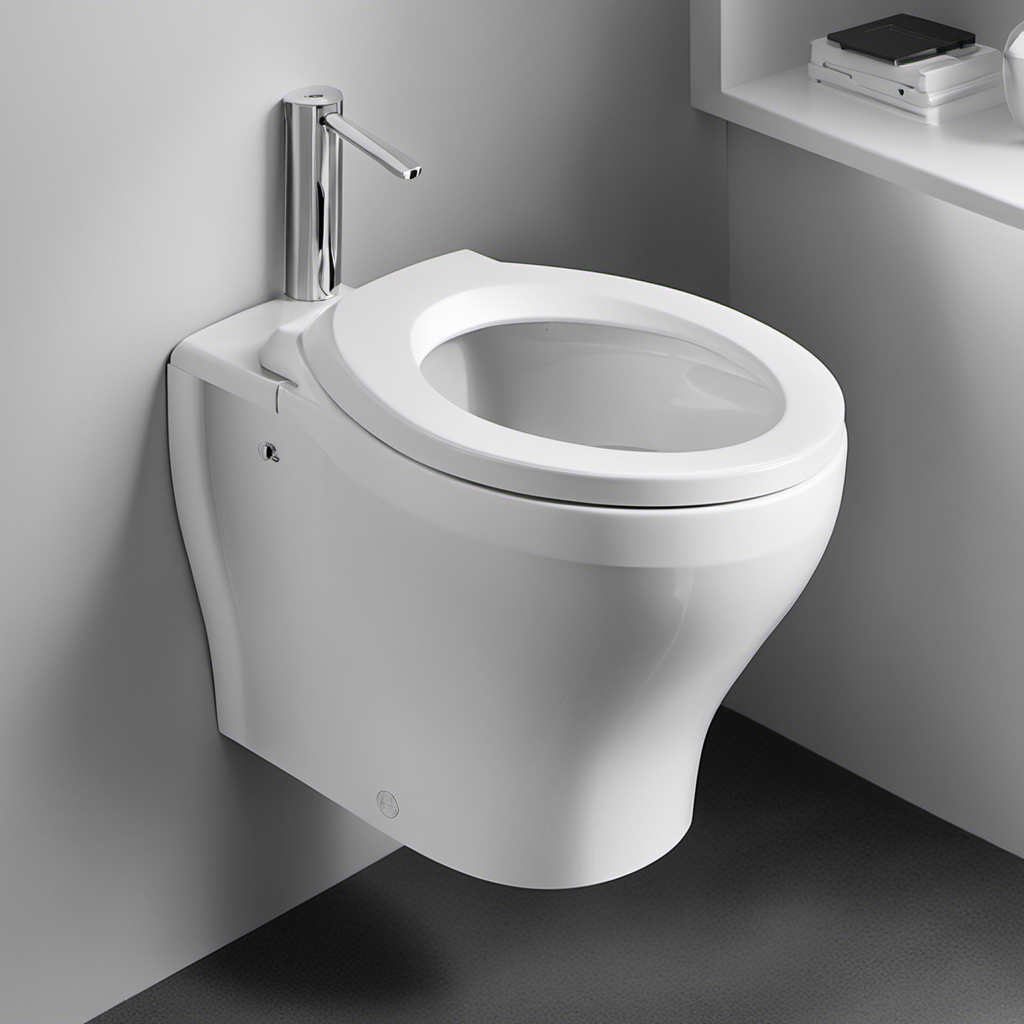Hey there!
Ever found yourself in a sticky situation with a clogged toilet? Well, fear not, because I’ve got just the solution for you.
In this article, I’ll be your trusty guide, showing you the ins and outs of using a plunger to unclog that stubborn toilet.
So, grab your plunger and let’s dive right in. Together, we’ll tackle this messy problem and have your toilet running smoothly in no time.
Let’s get plunging!
Key Takeaways
- A plunger is a tool used to clear blockages in toilets and drains.
- Different types of plungers are available, such as the standard cup plunger and the flange plunger designed for toilets.
- Position the plunger over the drain hole in the toilet bowl and press down firmly to create a tight seal.
- Use quick and forceful up and down motions to generate suction and continue plunging until the water level in the toilet bowl decreases.
What Is a Plunger and How Does It Work
To unclog your toilet, you’ll want to know what a plunger is and how it works.
A plunger is a simple but effective tool used to clear blockages in toilets and drains. It consists of a rubber cup attached to a handle.
When using a plunger, you place the cup over the drain hole and create a seal by pressing it firmly against the surface. Then, using an up and down motion, you generate pressure that helps dislodge the clog.
There are different types of plungers available, such as the standard cup plunger and the flange plunger, which is designed specifically for toilets.
If a plunger is not available, you can try alternative unclogging methods such as using a toilet auger or a mixture of hot water and dish soap.
Gathering the Necessary Tools and Materials
First, you’ll need to gather all the tools and materials necessary for the task at hand. When it comes to toilet clog prevention and alternative unclogging methods, it’s important to be prepared.
Start by having a plunger on hand, as it is one of the most effective tools for unclogging a toilet. Make sure you have a plunger with a flange, as this design provides better suction.
Additionally, consider using a toilet auger or a drain snake for more stubborn clogs. These tools can help break up the blockage and clear the way for proper water flow.
Step-By-Step Instructions for Using a Plunger
Make sure you have a plunger with a flange, as it provides better suction and is essential for effectively tackling a stubborn clog.
To properly use a plunger, start by positioning it over the drain hole in the toilet bowl. Press down firmly, creating a tight seal. Then, vigorously pump the plunger up and down, using quick, forceful motions. This action creates suction and helps dislodge the clog.
Continue plunging until the water level in the toilet bowl starts to decrease. Once the clog is cleared, flush the toilet to ensure proper drainage.
Remember to clean and maintain your plunger after use by rinsing it with hot water and disinfectant.
If the plunger method doesn’t work, you can try alternative unclogging methods such as using a plumbing snake or a mixture of baking soda and vinegar.
Techniques for Effectively Unclogging a Toilet
When it comes to unclogging a toilet, proper plunger usage is essential. Understanding how to use a plunger correctly can make all the difference in effectively clearing a clog.
However, sometimes issues may arise even with proper plunger usage, and troubleshooting common problems is crucial.
Lastly, to prevent future clogs and maintain a smoothly functioning toilet, there are a few maintenance tips to keep in mind.
Proper Plunger Usage
To properly use the plunger, you’ll need to create a tight seal around the drain opening. This ensures that the force you apply is directed towards unclogging the toilet. Here are some key tips for proper plunger usage:
-
Plunger maintenance:
-
Clean your plunger after each use to prevent the spread of bacteria.
-
Store your plunger in a dry place to avoid mold and mildew growth.
-
Replace your plunger if it becomes worn or damaged.
-
Different types of plungers:
-
Cup plungers are ideal for sinks and flat surfaces.
-
Flange plungers are designed for toilets with a built-in flange.
-
Accordion plungers are versatile and can be used on various drains.
By following these maintenance tips and selecting the right plunger for the job, you’ll have an effective tool for unclogging toilets.
Now, let’s move on to troubleshooting common issues.
Troubleshooting Common Issues
Now that we’ve covered the proper usage of a plunger, let’s talk about troubleshooting common issues that may arise while unclogging a toilet.
One common problem is an overflow situation. If you notice the water level rising and nearing the rim, it’s important to act quickly to prevent a messy situation. Start by turning off the water supply valve behind the toilet. This will stop the water flow and prevent any further overflow.
If the water level continues to rise despite your efforts, it’s best to call a professional plumber for assistance. Dealing with clogs and overflow situations can be stressful, but with the right knowledge and quick actions, you can effectively handle these issues.
Now, let’s move on to the next section where we will discuss prevention and maintenance tips to keep your toilet clog-free.
Prevention and Maintenance Tips
If you want to keep your toilet clog-free, it’s important to regularly clean the inside of the bowl with a toilet brush and disinfectant. By following these prevention tips and maintenance techniques, you can minimize the chances of experiencing a clogged toilet and the need for plunging.
Be mindful of what you flush down the toilet, avoiding items like wet wipes, sanitary products, and excessive toilet paper.
Consider installing a toilet paper holder that limits the amount of paper dispensed at once.
Use a drain strainer to catch any hair or debris that could potentially clog the toilet.
By incorporating these simple habits into your bathroom routine, you can reduce the likelihood of dealing with a clogged toilet and the hassle of plunging.
However, in the event that a clog does occur, it’s important to know how to troubleshoot common issues with plunging.
Troubleshooting Common Issues With Plunging
When it comes to troubleshooting common issues with plunging, there are a few key points to keep in mind.
Firstly, insufficient water level can greatly hinder the effectiveness of plunging.
Secondly, improper plunging technique can also contribute to a lack of success.
And finally, if stubborn clogs persist despite your efforts, it may be time to consider alternative methods or seek professional help.
Insufficient Water Level
To unclog the toilet successfully, it is important to have enough water in the bowl. Insufficient water level can hinder the effectiveness of plunging and prolong the unclogging process. Here are three reasons why maintaining an adequate water level is crucial:
- Proper water level ensures better suction, allowing the plunger to create the necessary pressure to dislodge the clog.
- Adequate water acts as a lubricant, making it easier for the plunger to move up and down smoothly.
- Ample water prevents the plunger from introducing air into the drain, which can push the clog further down the pipe.
To prevent clogs and maintain a sufficient water level, consider these tips:
- Avoid flushing excessive toilet paper or feminine products.
- Use a toilet paper that dissolves easily.
- Regularly clean the toilet and check for any potential clog-causing items.
Now that we understand the importance of water level, let’s move on to the next section: improper plunging technique.
Improper Plunging Technique
When it comes to unclogging a toilet, using the proper plunging technique is crucial. Unfortunately, many people make common mistakes that can worsen the situation.
One of the most common mistakes is using the plunger incorrectly. Instead of using quick, forceful plunges, some people make the mistake of using slow, gentle pushes. This is ineffective because it doesn’t create the necessary pressure to dislodge the clog.
Another mistake is not creating a proper seal between the plunger and the toilet bowl. This can result in air escaping and reducing the plunging power. To avoid these mistakes, it’s important to use a plunger with a flange, as it creates a better seal.
Additionally, using quick, forceful plunges will generate the necessary pressure to unclog the toilet effectively.
Stubborn Clogs Persist
Despite using the proper plunging technique, stubborn clogs can still persist in the toilet. It can be frustrating when you’ve followed all the steps correctly, yet the clog remains.
There are a few reasons why this might happen:
-
Insufficient water level:
Sometimes, the water level in the toilet bowl is not enough to create the necessary pressure for effective plunging. This can happen if the toilet hasn’t been used for a while or if there’s a problem with the water supply. -
Improper plunging technique:
Even though you think you’re using the right technique, it’s possible that you’re not applying enough force or not creating a proper seal between the plunger and the drain. This can prevent the necessary suction needed to dislodge the clog. -
Deeper clog:
In some cases, the clog may be located further down the drain pipe, making it difficult to reach with a plunger. This might require the use of specialized tools or the assistance of a professional plumber.
Preventative Measures to Avoid Future Clogs
One way you can prevent future clogs is by regularly cleaning the toilet bowl. Toilet clog prevention is essential to maintaining a properly functioning bathroom. By adopting some best practices, you can minimize the risk of clogs and ensure a hassle-free experience.
Firstly, it’s important to avoid flushing items that are not meant to go down the toilet, such as wipes, feminine hygiene products, or excessive amounts of toilet paper.
Secondly, consider using a toilet bowl cleaner regularly to remove any buildup or residue that can contribute to clogs.
Additionally, make sure to teach everyone in your household about proper toilet usage, emphasizing the importance of flushing only waste and toilet paper.
Conclusion
In conclusion, using a plunger to unclog a toilet is a simple yet effective technique that can save you from a messy situation.
By following the step-by-step instructions and employing the right techniques, you can easily clear any blockage in your toilet.
Remember to gather the necessary tools and materials beforehand and troubleshoot any issues that may arise.
By taking preventative measures, such as being mindful of what you flush down the toilet, you can avoid future clogs and keep your bathroom running smoothly.
